Amidst increasing geopolitical competition, Western scholars and policymakers have increasingly looked at Russia as the main threat to the Trans-Atlantic security environment since the 2010s. In response to Russia’s rediscovered assertiveness and its destabilizing posture, most notably in Ukraine, numerous new theories and concepts have been put forward to describe Russia’s actions and decipher its strategy. Heading this illustrious list is undoubtedly Hybrid War, followed by concepts such as Grey Zone, Nonlinear or New Generation Warfare, and full-spectrum conflict, which are often used interchangeably.[1] However, many of these concepts do not appear in the Russian military lexicon, and those that do often refer to something different from the generally accepted Western definitions.
This highlights the inherent problem of intercultural translation.[2] The risk of ascribing Western stereotypes to Russian thought has already been mentioned by several authors, yet this problem persists. Russian military thinking is distinct. It is shaped by its unique geography, history, society and political culture. Without appreciation of its strategic culture and unique perspective, Russia’s way of war cannot be fully understood.[3] Nevertheless, novel Western concepts continue to dominate the debate on Russian military thought and strategy, both in the academic and policy realm. Notwithstanding their respective differences and proclivities, at least three central tenets can be distinguished amongst them.

Russian military thinking is distinct. It is shaped by its unique geography, history, society and political culture. Photo Kremlin
Firstly, these concepts generally identify a critical juncture in current Russian strategic and operational conduct. Russia is often heralded as the developer of a new kind of warfare, structurally different from the more conventional notions of war. This sense of novelty is mainly based on the second tenet; the extent to and manner in which nonmilitary means are incorporated within Russia’s thinking on contemporary war. Lastly, Western interpretations of Russian military thought often state that Russia is increasingly blurring the distinction between war and peacetime. By focusing on Russia’s so-called measures short of war, it is assumed that a confrontation with Russia will largely take place outside the traditional domains of war.
This article aims to provide more nuance to this by scrutinizing these assertions. Subsequently, the main contours of contemporary Russian military thought will be outlined. It is necessary to go beyond the hype of the current buzzwords, by delving deeper into the continuous factors that define Russian military thought, drawing upon primary sources and key debates within the Russian Ministry of Defence.
Assertion 1: Russia’s current understanding of war is fundamentally new
It is often claimed that Russia has introduced a new kind of war. Whether it is through concepts such as New-Generation War, or notions of Putin ‘reinventing warfare’, an apparent novelty in Russia’s military thinking and conduct has been discerned that breaks with traditional and established military thinking.[4] Evidence for this is mainly drawn from the experience in Crimea, Eastern Ukraine and Syria, and the subsequent use of nonmilitary means such as cyber-attacks, (dis)information campaigns and the protest-potential of a population. This has led analysts to label Russia’s military conduct as a ‘new way of war’.[5] However, much of what is considered new in these cases is actually reminiscent of Soviet and even Tsarist military practice. This raises the question of how new Russia’s contemporary military thought actually is.
Mark Galeotti has identified a distinct historical precedent of using a mix of conventional and irregular forces, employing a range of military, unconventional and subversive activities.[6] During the Tsarist conquests of the North-Caucasus, the Russian armed forces often cooperated with local rebels, warlords and strongmen. Similarly, units of famous Russian commander Mikhail Frunze’s Turkestan armies sometimes consisted of 40 per cent local forces. In addition to the incorporation of irregular and local forces, unconventional tactics were often employed. For example, special Bolshevik units, the Chasti Osobogo Naznacheniya, often operated as ‘pseudo-gangs’ and rebel groups, conducting ambushes and false-flag operations.[7] The Soviet partisan movement followed accordingly during the Second World War as they carried out a wide range of subversive activities. Likewise, during the Soviet-Afghan war, rivalries amongst rebel factions were fomented, provocations were staged and information war played a central role throughout. Recent experiences in Crimea and Eastern Ukraine follow this precedent quite closely.
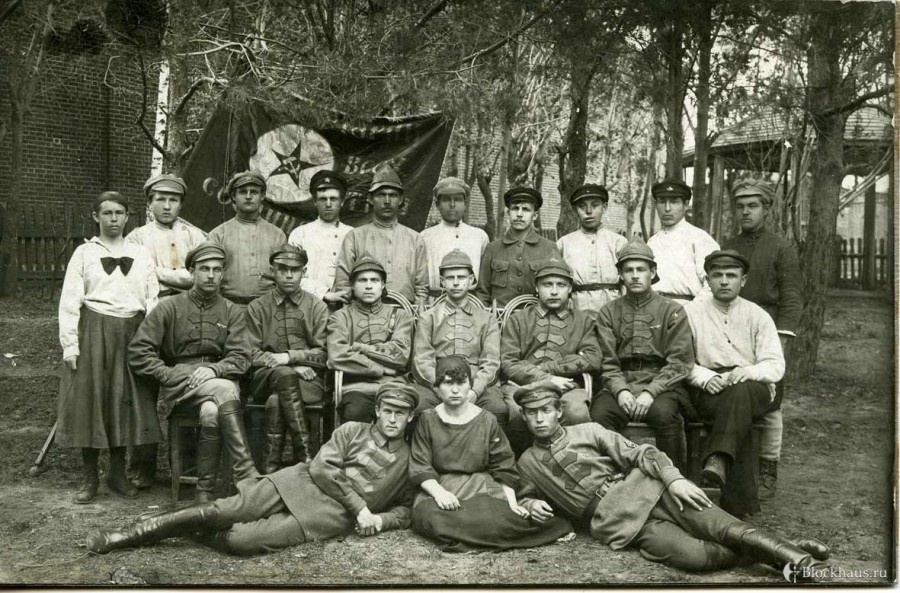
Special Bolshevik units, the Chasti Osobogo Naznacheniya, often operated as ‘pseudo-gangs’ and rebel groups. Photo istoriki.su
This habit of using irregular forces and methods that support conventional means are partly driven by pragmatism. In pursuit of great power status, Russia has always had to balance its assertive posture with relatively limited resources.[8] Consequently, it was necessary to incorporate innovative and unconventional force multipliers against better-equipped opponents.[9] More importantly, however, Russia has historically always had a rather holistic view of war and interstate competition, which includes all main aspects of society.
One of the main proponents of such a broad conceptualization of war was Major General Svechin, who in the early 20th century stated that the entire rear area of an opponent, comprised of its socio-political and economic capabilities, should be taken into consideration by the strategist.[10] It was Svechin who in 1926 already sketched the contours of a form of offensive political warfare when he stated that ‘This political goal, namely splitting a hostile state into individual political fragments, involves a study of the domestic situation’.[11] Similarly, former chief of the general staff and Marshal of the Soviet Union Sokolovsky perceived strategy as inherently related to other social and natural sciences, as he paid particular attention to the political, economic and moral factors of a society at war.[12] From the Bolshevik period onwards, interstate confrontation is seen as a sum of socio-political economic and military aspects, differentiating it from the more narrow Western perspectives.
Consequently, the opponent in war is not seen as the total sum of its armed forces, but rather as a complex system of material and cognitive factors.[13] Just as all aspects of Russian society are involved in war, every aspect of the opponent’s society is engaged in war, and is therefore seen as a legitimate target. Such a holistic approach to war is also reflected in the official military doctrines today. From 2000 onwards, Russia’s security is defined in terms of the state, society as a whole and the individual, which can be safeguarded through the ‘integrated employment of military force and political, economic, informational or other non-military-measures’.[14] War as a general phenomenon cannot be seen in isolation. Rather, Russia sees the use of armed force as part of a bigger toolbox, consisting of various means which can all be used against an opponent to pursue a political goal.
Thus, conventionally speaking, Russia’s understanding of war has always been comprehensive and receptive to the importance of all aspects of society. The blend of conventional and irregular forces and means, too, is firmly established in Soviet and Tsarist military conduct. Therefore, Russia’s new and unconventional way of war is not that new, nor that unconventional.
Assertion 2: The importance of nonmilitary means in war has surpassed that of the military means
Much attention has been paid to Russia’s use of unconventional and nonmilitary means over the last decade. The continuous development of information and communication technologies and the ever-increasing interconnectedness between societies has expanded Russia’s reach and toolbox to exert influence.[15] Consequently, Russian military thought has increasingly been defined by a wide range of subversive instruments, most of which reside outside of the military realm.[16] Information warfare, propaganda, cyberattacks, various political and economic instruments and the covert deployment of special forces are seen as the primary means through which Russia aims to destabilize societies and coerce opposing governments.[17] Consequently, it is assumed that Moscow will seek to minimize its use of conventional and nuclear forces.[18] For example, Oscar Jonsson states that Russian military thought holds ‘nonmilitary means to be the preferred method and military means to be the last resort’.[19] Moreover, it is argued that the objectives of war no longer include the destruction of enemy forces and the physical conquest of territory, but instead revolve around the creation of ‘controlled chaos’ through which Russia can exert influence. Subsequently, the inference is made that ‘the direct use of military means is not the most important method used against other military means’.[20]
In part this has been substantiated by a number of Russian articles and speeches. For example, in his well-known 2013 speech, General Gerasimov estimated the role of nonmilitary means over military means at a ratio of 4:1. This assertion, however, was mainly based on the analysis of how the US operated in Iraq and Libya.[21] Moreover, S.G. Chekinov and S.A. Bogdanov claim that nonmilitary options have become greatly superior to the power of weapons in what they call ‘New Generation Wars’.[22] The decisive battles of war, they argue, will therefore take place in the information sphere. Additionally, Andrey Kartapolov stated that conflicts are no longer 80 per cent violence and 20 per cent propaganda, but rather vice versa.[23] Although these articles have at times been misinterpreted or taken out of context, they continue to be fed into Euro-Atlantic analysis of Russian military thinking.
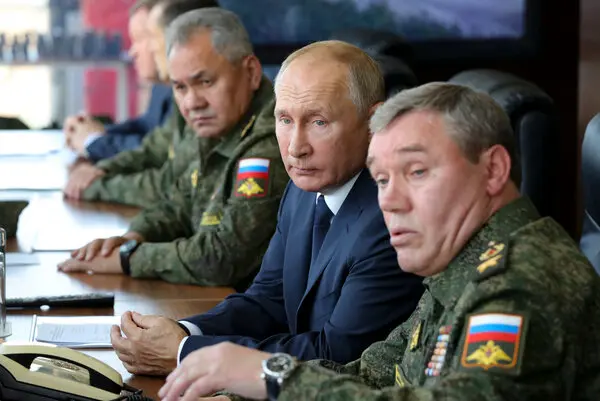
Russian President Putin, with Minister of Defence Shoygu on his left and former Chief of the General Staff Gerasimov on his right. Photo Kremlin
Consequently, it is assumed that the Russian military leadership has identified a ‘role-reversal’ in the relationship between military and nonmilitary means.[24] Kinetic means are now seen as inherently subordinate to the overall information campaign and other non-traditional means.
However, Gerasimov stated that the main content of wars in the present and the foreseeable future is and remains the use of conventional armed force.[25] This is further illustrated by Michael Kofman, who argues that ‘the thrust of military strategy is conventional and nuclear warfare. Use of military power remains decisive.’[26] Although the ‘4:1 fallacy’ and related misconception that nonmilitary means now constitute the core of Russia’s way of war remains persistent, conventional military capabilities are still the dominant feature.
Yet the debate on the essence of war remains active in Russia, particularly since 2017.[27] At the starting point of this discussion, war was defined as the resolution of interstate contradictions through the use of military force. There are those who advocate for this definition to include nonmilitary aspects, as opposed to those who seek to preserve it. Although this debate has not produced a final answer, it could preliminarily be concluded that the Russian definition of war has indeed expanded, but that there is no reason to assume that the importance of nonmilitary means has exceeded that of the military means.[28]
It is generally acknowledged that the methods of interstate struggle have indeed become blended with nonmilitary means, which are able to affect the cause and outcome of an armed conflict. However, the current debate in Russia on the nature of war reflects a clear tendency to regard the use of armed force as the essence of war.[29] Even Chekinov and Bogdanov, who are often portrayed as the main proponents of Russia’s shift towards nonmilitary means, stated that the ‘main specific feature of war is attaining its goals by organized actions of the armed forces’.[30] The development of nonmilitary means is seen as a rather independent trend, with its own strategies, methods of employment and resources, distinct from the armed forces.[31] This was reiterated in 2019 at the Academy of Military Science in Moscow, where the yearly round table conference was concluded with the message that despite the ‘appearance of new spheres of confrontation in contemporary conflicts […] the main content of military strategy comprises issues of the preparation for war and its conduct, primarily in the Armed Forces’.[32]
It would be too shortsighted, or dangerous even, to reduce Russia’s understanding of war as a collective of nonmilitary means. As noted by Kofman, whilst analysts and pundits have focused a great deal on the discourse of nonmilitary means, Russia is rapidly ramping up its conventional military capabilities.[33] Instead of a sudden paradigm shift following the events in Ukraine and Syria, Russia acknowledges a more gradual shift in the methods of struggle towards a comprehensive set of measures, all of which structurally rely on military force.[34]
Assertion 3: Wars involving Russia will mainly take place in an ambiguous ‘Grey Zone’ between war and peace
The salience of nonmilitary means has given rise to the idea that wars involving Russia will no longer be formally declared, but rather take place below the threshold of war. Mainly used to describe this development is the concept of ‘Grey Zone’, which refers to an ambiguous space between peaceful statecraft and armed conflict. By seemingly blurring the lines between war and peace, Russia is arguably able to compete against adversaries, using multiple measures short of war in such a way that they do not provoke or justify a forceful response.[35] Director of the Information Center for Questions of International Security in Moscow Alexandr Bartosh stated that ‘Today, geopolitical competition between centers of power is increasingly playing out in the gray zone (GZ), which encompasses a space that goes beyond diplomacy and is not associated with conventional war’.[36] Although Russia accuses the West of operating from the Grey Zone, and vice versa, it is generally acknowledged that this is the main space in which confrontation will take place.
This conviction is not free of risk, which is illustrated by Donald Stoker and Craig Whiteside, who argue that the focus on the ill-defined Grey Zone is an example of the failure to think clearly about war and peace, and what connects and distinguishes them in Russian military thought.[37] Moreover, thinking in these terms of war in the Grey Zone only serves to create confusion regarding Russia’s military capabilities and intentions, and ‘draws a veil’ over the importance of the conventional aspects in Russia’s thinking.[38] Therefore, those who use the Grey Zone as the main frame of reference for analyzing Russian military thought are at risk of misdiagnosing it.
Assessing whether Russia has indeed blurred the lines between war and peace requires a better understanding of how Moscow distinguishes the two, and what that means for the methods it employs.
From a Russian perspective, international politics is a permanent process of rivalry, periodically interrupted by stints of war.[39] Therefore, competition is always present, and war and peace are thus merely different stages of the same ongoing process. Within this competition, each state has political interests it seeks to achieve, for which various elements of national power (e.g. diplomacy, economic persuasion/coercion, the military) can be employed.[40] This is known as grand strategy; the integrated employment of the state’s tools of power to pursue political objectives. Consequently, the Russian understanding of peacetime is largely defined by competition with measures short of war, which includes the use of violence as long as it does not lead to armed conflict. During wartime, the nonmilitary means become subordinated to the use of armed force as the main characteristic of war.
Recently, however, Russia’s use of nonmilitary means as part of its grand strategy has been interpreted as a form of war. What Moscow sees as normal conduct within the sphere of natural competition amongst states has been understood as war within the Grey Zone. In 2015, General of the Army, the late Gareyev, voiced his concerns on this misuse of the term war when he stated that: ‘Some philosophers, presenting very little knowledge of history, have claimed that all non–military means have appeared only in the present times and, basing on that assumption, they treat the use thereof as a war’.[41] Rather, he argues, the fight without force or weapons takes place during peacetime, whereas only the continuation of this policy by use of violence and armed force can be seen as war. Similarly, Russian Colonel Babych distinguishes between ‘peacetime-confrontation’, which can take on multiple forms, and war, which main characteristic is military actions. This clear distinction between war and peace can also be observed in Soviet military thought. For example, Marshal Sokolovsky delineated war by means of military actions carried out by an army, whereas the nonmilitary confrontation between states happens all the time. This could potentially explain why Russia uses the term ‘information confrontation’ as opposed to the Western notion of ‘information warfare’.[42]
This may seem incompatible with Russia’s holistic view of war. On the one hand, war is a complex socio-political issue, interrelated with all key dynamics of society. On the other, Russia only speaks of war when armed force is used. The balance between these two ideas becomes clear from the hierarchy between politics, grand strategy and the use of armed force. It is the responsibility of the politician to develop a grand strategy, drawing upon the various elements from his toolbox, to achieve the political objectives. In Russian thinking, the use of armed force is seen as an ‘ordinary’ and legitimate instrument alongside other, nonmilitary instruments, which can jointly serve the same purpose.[43] As Michal Wojnowski argues: ‘war with its nature restricted to military actions becomes only one of the ways to achieve political goals’.[44] Although war in and of itself is characterized by the use of armed force, it does not occur in isolation. It should be seen in conjunction with other economic, informational and political tools in the box, which are continuously employed and can synergize the effort of the armed forces.
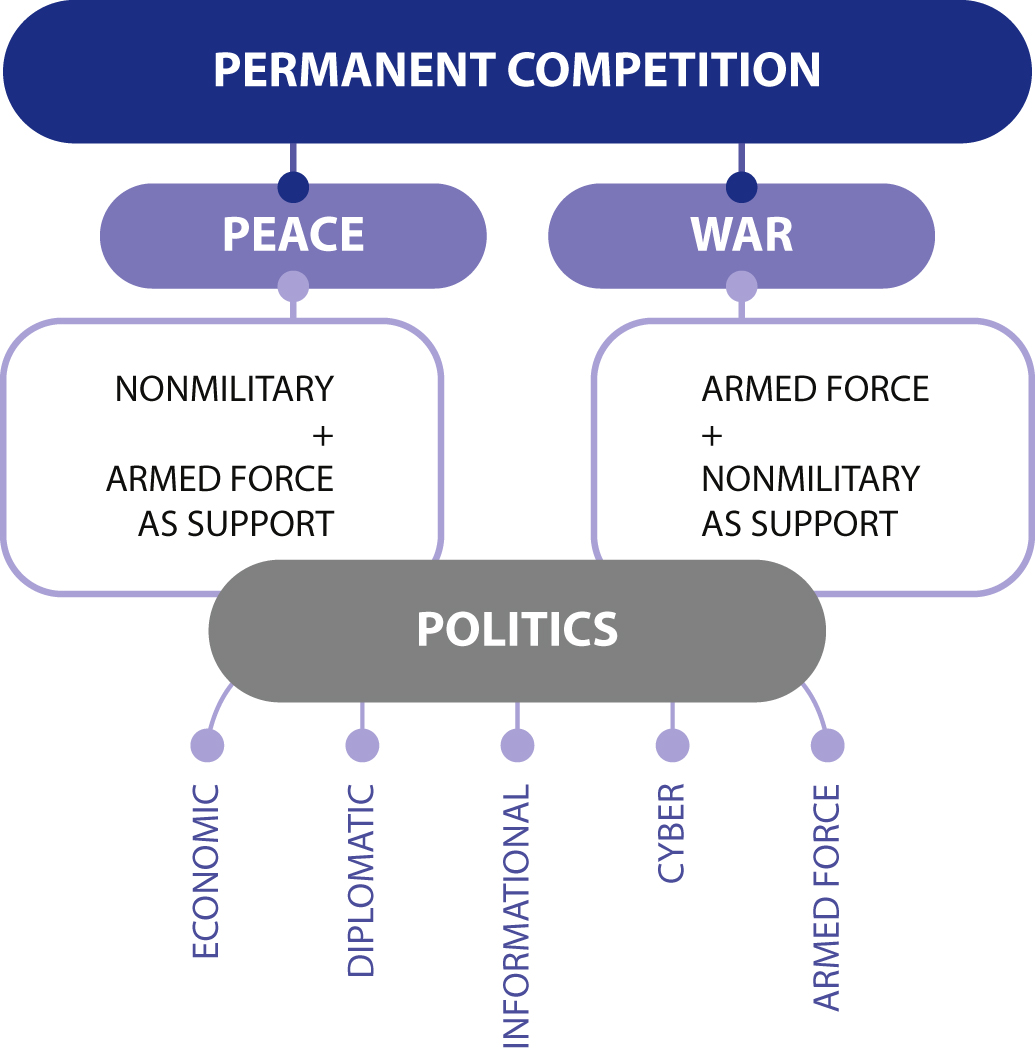
Figure 1 Peace and war as opposing stages of the same process: permanent competition
Although concepts such as the Grey Zone suggest otherwise, there is a clear line between war and peace in Russian military thinking. The assumption that wars involving Russia will mainly take place below the threshold of war is not only a contradictio in terminus, it is a misconception that denies the central role that armed forces play in war. Therefore, much of what is now seen as the use of ‘measures short of war’ should actually be seen through the prism of grand strategy, which is used in a permanent geopolitical struggle.
How Russia understands conflicts and how it develops strategy
Having scrutinized three persistent misinterpretations, the question of how Moscow does understand war, and how it subsequently develops strategy, can be raised. From a Russian perspective, every conflict is unique and demands its own approach. This line of thought can be traced back to at least the 18th century, when Russian General Suvorov noted that strategy does not follow a model, but is heavily dependent on the given circumstances. Svechin elaborated on this in the early 20th century, arguing that each armed conflict is a partial case, for which its own logic needs to be established. Similarly, it was Sokolovsky who defined strategy as always changing, dependent on the context, the given time and means available. These ideas are still being repeated today by the Russian military leadership, illustrated by Gerasimov, who stated that each conflict has a unique logic of its own.[45]
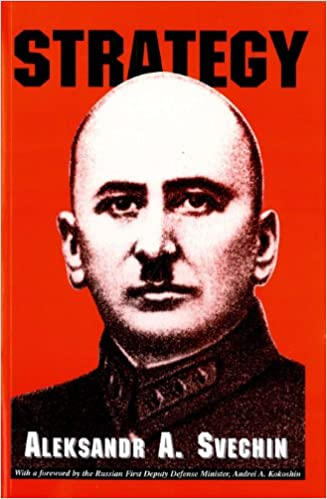
Aleksandr Svechin’s seminal 1926 book Strategy, which still carries great weight today
When differentiating between the context in which a conflict takes place, and the subsequent strategy that needs to match this context, a distinction can be made between the objective factors (i.e. the context, military capabilities and the surrounding reality) and subjective factors (the commander’s knowledge, experience and comprehension of the situation).[46] The two are seen as inherently interrelated and come together in military practice. In Russian military thought, it is only through creative thinking that a commander is able to use his subjective knowledge to influence and exploit the objective situation. As Timothy Thomas states: ‘Creative strategy can be expressed as subjective thought applied to a commander’s objective situation’.[47] Creative use of the subjective factors thus enables the development of an original strategy for any conflict that best matches a specific set of objective circumstances.
It is, however, an essential prerequisite for a commander to have an adequate grasp of the objective factors before a creative strategy can be developed. This too has already been outlined by Svechin, who stated that the forms and methods of warfare depended on changes in the political, economic and military-technological sphere, and that it was the task of military art to develop commanders’ independent and creative thinking.[48]
This is illustrated by the importance of foresight, forecasting and the analysis of the correlation of forces and means (COFM). The Russian armed forces are exceptionally concerned with studying the continuous developments and trends of war. Forecasting (closely related to foresight; often used synonymously) can be defined as a research process into the military-political situation, the objective patterns and mechanisms of war in a specific context.[49] Both Gareyev and Gerasimov[50] have continuously advocated the need to further advance the scientific methods for forecasting/foresight.[51]
Similarly, the rather mathematical study of enemy forces in relation to the Russian forces is of great importance to the Russian armed forces. The correlation of forces and means takes into account the quality and quantity of a warring side, which is ultimately translated into a numerical indicator of combat power. These two components cannot be seen separately.[52] This is further illustrated by Mikhail Frunze, who argued that foresight is dependent on a) a clear understanding of the nature of future war, b) an accurate account of enemy forces and c) an accurate account of friendly forces.[53]
Through forecasting, it has become apparent that the objective circumstances have changed, as societies have become more globalized and digitalized. The manner in which Russia creatively deals with this has not changed, but merely responds to the circumstances. As Nicolò Fasola states: ‘Russia has been receptive to these changes, and able to use them at its own advantage’.[54] Russia’s ability to modify and adapt its strategy in response to changing environments and different threats is not the sign of an innovative new way of conducting war, but rather the appropriate application of a well-established idea.
Conclusion
After Crimea and Eastern Ukraine, Russia’s military thought and the subsequent speeches and articles of high-ranking officers have received a tremendous amount of attention. Yet single articles or speeches cannot be equated with formal doctrine, just as the experience in Crimea does not provide a universal model for Russian strategic and operational conduct. As Thomas noted: ‘models and dictionary definitions are useful to a point, but unique logic applied to the situation at hand (along with practical experience in the use of foresight and the COF[55]) may best demonstrate the basis for Russian strategic thinking and creativity.’[56] It is necessary to draw upon established principles and Russia’s unique perspective to accurately understand its current assertive posture and contemporary military thought.
It would, however, be too shortsighted to argue that everything has stayed the same since the Soviet and Tsarist days. Although the same core principles can be observed in Russia’s contemporary military thought, the objective circumstances in which war takes place have developed further. As Galeotti argues: ‘What really has changed is the context in which old methods are being applied’.[57] The current pace at which this objective reality develops, with economies becoming increasingly intertwined, changes in the socio-political landscape and advances in informational and military technologies, only emphasizes the need to closely monitor how Russia adapts to this, and exploits it.
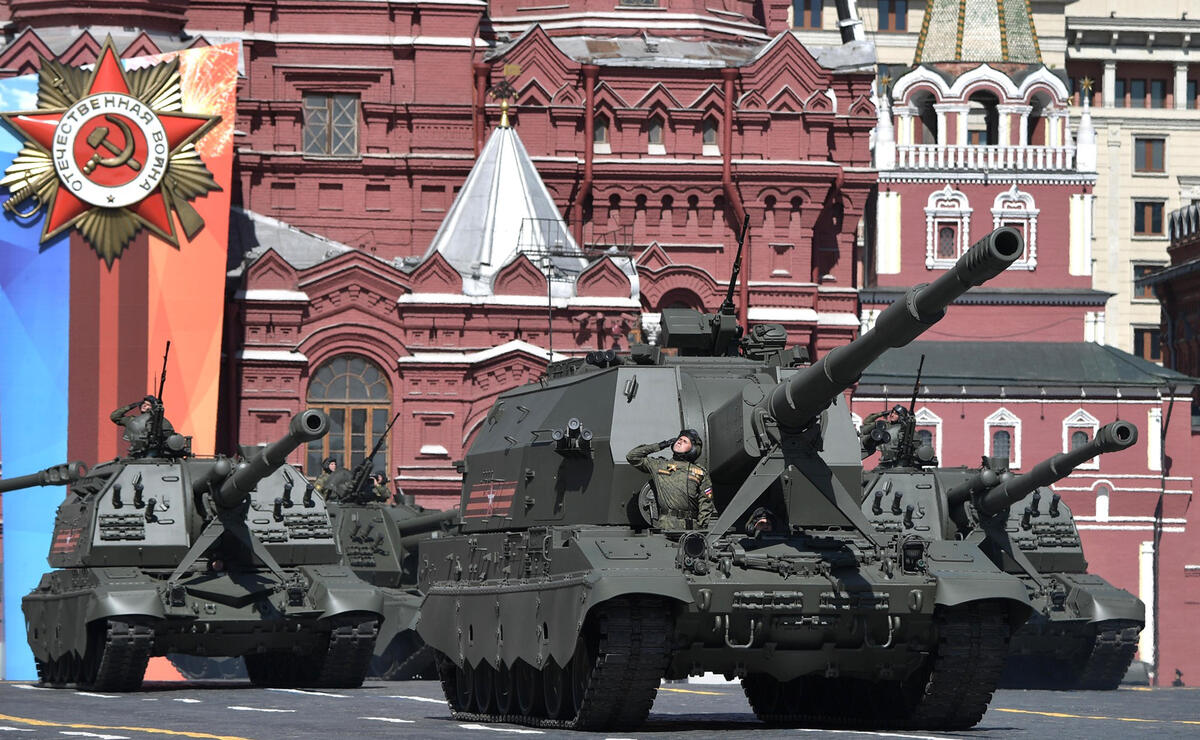
Military parade in Moscow. From 2008 onwards, Russia has sought to structurally professionalize and modernize its armed forces, with varying degrees of success. Photo Kremlin
Nevertheless, the general focus has largely shifted, for example, towards Russian hackers and troll-farms spreading disinformation, causing the development and procurement of modern weapon systems and the creation of new units in the Russian armed forces to be overlooked. As Andrew Monaghan argues: ‘Any reference to […] the growing importance of non-military means in Russian thinking must therefore be balanced against President Putin’s statement in 2015 that “a great deal has been done over the course of the past year to expand the potential of our armed forces.”’[58] Or, as Thomas argues: ‘in spite of these Western accusations [of Russia using Hybrid War], Russia’s military continues to utilize its traditional building blocks of military thought’.[59]
Perhaps Hybrid Warfare’s most cunning accomplishment is the widespread dispersion of the illusion that future wars can be fought without actual fighting. As we have become fixated on what is happening below the formal threshold of war, we become increasingly indifferent to what could potentially happen once this threshold is crossed.
[1] T.L. Thomas, Russian Military Thought: Concepts and Elements (McLean VA, MITRE Corp, 2019) 1.
[2] A. Monaghan, How Moscow Understands War and Military Strategy (CAN Occasional Paper Russia Research Network & Royal United Services Institute, 2020) 6.
[3] A.I. Johnston, ‘Thinking about strategic culture’, in: International Security 19 (1995) (4) 32-64, 34.
[4] M. Galeotti, ‘Hybrid, ambiguous, and non-linear? How new is Russia’s “new way of war”?’, in: Small Wars & Insurgencies 27 (2016) (2) 282-301, 282.
[5] P.A. Mattsson, ‘Russian military thinking–A new generation of warfare’, in: Journal on Baltic Security 1 (2015) (1) 61-70, 62; C. Kasapoglu, Russia’s Renewed Military Thinking: Non-linear Warfare and Reflexive Control (NATO Defense College, Research Division, 2015) 1.
[6] Galeotti, ‘Hybrid, ambiguous, and non-linear?’, 293.
[7] Ibidem, 294.
[8] A. Stent, Het Rusland van Poetin: Rusland tegen het Westen (Amsterdam, Spectrum, 2019) 52.
[9] Galeotti, ‘Hybrid, ambiguous, and non-linear?’, 297.
[10] Andrei A. Kokoshin, Soviet Strategic Thought, 1917-1991 (Cambridge MA, MIT Press, 1998); T.L. Thomas, Russia Military Strategy. Impacting 21st Century Reform and Geopolitics (Fort Leavenworth KS, Foreign Military Studies Office, 2015) 64.
[11] B. Friedman, ‘#Reviewing The Russian Understanding of War’, The Strategy Bridge, 2020. See: https://thestrategybridge.org/the-bridge/2020/3/24/reviewing-the-russian-understanding-of-war.
[12] Thomas, Russia Military Strategy, 64.
[13] M. Wojnowski, ‘Paradigm of war and peace. The role and significance of dialectical materialism in the Russian military science of the 21st century’, Przegląd Bezpieczeństwa, 2017, 303.
[14] N. Fasola, Principles of Russian Military Thought (Institute of International Relations Prague, 2017) 4.
[15] Mattsson, ‘Russian military thinking’, 61; A.V. Romanchuk, P.A. Dulnev, P.I. Orlyansky, ‘The changing nature of warfare: experience of early 21st-century armed conflicts’, in: Voennaya Mysl (Military Thought) 3 (2020) 107-123, 108.
[16] M. Clark, Russian Hybrid Warfare (Institute for the Study of War, 2020) 8.
[17] A. Monaghan, ‘Understanding Russia’s measures of war’, in: Russian Analytical Digest, 259 (2020) 3.
[18] C.S. Chivvis, Understanding Russian “Hybrid Warfare” (Rand Corporation, 2020) 2.
[19] O. Jonsson, The Russian understanding of war: blurring the lines between war and peace (Washington, D.C., Georgetown University Press, 2019) 154.
[20] Mattsson, ‘Russian military thinking’, 66.
[21] V.V. Gerasimov, ‘Principal Trends in the Development of the Forms and Methods of Employing Armed Forces and Current Tasks of Military Science Regarding Their Improvement’, in: Vestnik Akademii Voennykh Nauk 1 (2013) (Journal of the Academy of Military Science) 24–29.
[22] S.G. Chekinov, and S.A. Bogdanov, ‘On the Character and Content of Wars of a New Generation’, in: Voennaya Mysl (Military Thought) 4 (2013) 13–24, 18; S.G. Chekinov and S.A. Bogdanov, ‘The Essence and Content of the Evolving Notion of War in the 21st Century’, in: Voennaya Mysl (Military Thought) 26 (2017) 71-86, 72.
[23] A.V. Kartapolov, ‘Lessons of Military Conflicts and Prospects for the Development of Resources and Methods of Conducting Them. Direct and Indirect Actions in Contemporary International Conflicts’, in: Vestnik Akademii Voennykh Nauk 2 (2015) (Journal of the Academy of Military Science) 33.
[24] Clark, Russian Hybrid Warfare, 21.
[25] V.V. Gerasimov, ‘Мир на гранях войны | Еженедельник «Военно-промышленный курьер»’, Vpk-news.ru (2017). See: https://www.vpk-news.ru/articles/35591.
[26] M. Kofman, ‘Russia’s armed forces under Gerasimov, the man without a doctrine’, Russia Military Analysis (2020). See: https://russianmilitaryanalysis.wordpress.com.
[27] Monaghan, How Moscow Understands War and Military Strategy, 2.
[28] Thomas, Russian Military Thought, 9.
[29] A more comprehensive overview of the current debate can be found in Thomas, Russian Military Thought; Monaghan, How Moscow Understands War and Military Strategy, 4.
[30] Chekinov and Bogdanov, ‘The Essence and Content of the Evolving Notion of War in the 21st Century’, 72.
[31] Monaghan, How Moscow Understands War and Military Strategy, 3.
[32] V.V. Gerasimov, ‘The Development of Military Strategy under Contemporary Conditions. Tasks for Military Science’ (Развитие военной стратегии в современных условиях. Задачи военной науки), Вестник Академии военных наук) (2019) 4.
[33] Kofman, ‘Russia’s armed forces under Gerasimov’.
[34] Gerasimov, ‘The Development of Military Strategy’.
[35] Monaghan, ‘Understanding Russia’s measures of war’, 3.
[36] A. Bartosh, ‘Ход серым конем | Еженедельник «Военно-промышленный курьер»’ (2020). See: https://vpk-news.ru/articles/59752.
[37] D. Stoker, and C. Whiteside, ‘Gray-zone conflict and hybrid war-two failures of American strategic thinking’, in: Naval War College Review 73 (2020) (1) 19-54.
[38] Monaghan, ‘Understanding Russia’s measures of war’, 4.
[39] M. Wojnowski, ‘Paradigm of war and peace’, 302.
[40] Stoker and Whiteside, ‘Gray-zone conflict and hybrid war’, 5.
[41] M. Wojnowski, ‘Paradigm of war and peace’, 288.
[42] Ibidem.
[43] Fasola, Principles of Russian Military Thought, 12.
[44] M. Wojnowski, ‘Paradigm of war and peace’, 303.
[45] Thomas, Russia Military Strategy, 60.
[46] Ibidem, 49.
[47] Ibidem, 81.
[48] Kh.I. Saifetdinov, ‘Alexander Svechin, an Outstanding Military Thinker of the Early 20th Century’, in: Voennaya Mysl (Military Thought) 3: 136-146, 138.
[49] I.V.E. Chuyev and I.B. Mikhailov, Forecasting in military affairs: a Soviet view (No. 16, 1980). Published under the auspices of the U.S. Air Force, 13.
[50] Although the actual title is ‘Basic Tendencies in the Development of Forms and Methods of Employing Armed Forces and Current Tasks of Military Science Regarding their Improvement’, Gerasimov’s 2013 speech is often titled as ‘The Value of Science is in the Foresight’ – See T.L. Thomas, ‘The Evolving Nature of Russia’s Way of War’, in: Military Review 97 (2017) (4) 34.
[51] Gerasimov, ‘The Development of Military Strategy’; J.W. Kipp, The Russian Military and the Revolution in Military Affairs: A Case of the Oracle of Delphi or Cassandra? (Foreign Military Studies Office, 1995) 3.
[52] Chuyev and Mikhailov, Forecasting in military affairs, 14.
[53] Thomas, Russia Military Strategy, 54.
[54] Fasola, Principles of Russian Military Thought, 5.
[55] Correlation of Forces can be used synonymously with Correlation of Forces and Means in this case.
[56] Thomas, Russia Military Strategy, 21.
[57] Galeotti, ‘Hybrid, ambiguous, and non-linear?’, 297.
[58] Monaghan, ‘Understanding Russia’s measures of war’, 3.
[59] Thomas, Russian Military Thought, 9.